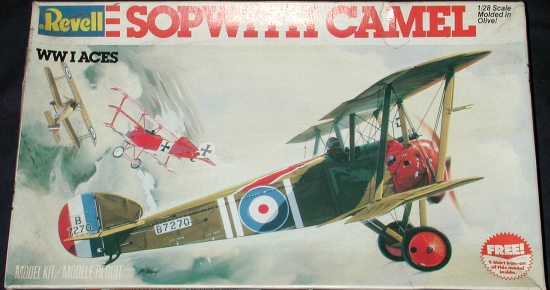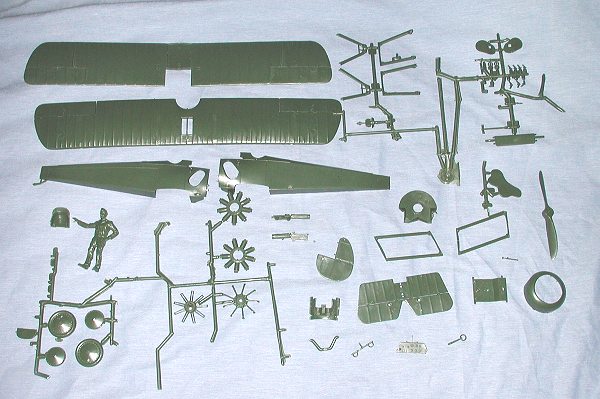
| KIT: | Revell 1/28 Sopwith Camel |
| KIT # | 4419 |
| PRICE: | $ |
| DECALS: | One aircraft |
| REVIEWER: | |
| NOTES: | 1981 reissue |

| HISTORY |
An agile, highly maneuverable biplane, the Sopwith Camel accounted for more aerial victories than any other Allied aircraft during World War I. Credited with destroying 1,294 enemy aircraft, it was called the Camel due to the humped fairing over its twin machine guns. Much like a real camel, this aircraft could turn and bite you. Noted for its tendency to kill inexperienced flyers, many pilots feared its vicious spin characteristics. Until sufficient speed was developed during takeoff, Camel pilots maintained full right rudder to counteract the torque the rotary engine. Failure to do so often resulted in a ground loop with the Camel crashing on its starboard wingtip. During World War I, 413 pilots died in combat and 385 pilots died from non-combat related causes while flying the Sopwith Camel.
| THE KIT |

This is one of three models that Revell did in 1/28 scale back in the early 1960's. The other two were the Fokker Triplane and Spad XIII. A few years back, they did a Fokker D.VII to add to that list, but much to the chagrin of modelers everywhere, it turned out to be a real pooch. That mostly having to do with a very poorly done upper wing.
Anyway, Baby Boomer modelers have built at least one of these three planes. They were fun because they were large and because they had cool box art! The kit itself has soldiered on rather well over the years. There are the usual problems with ejector pin marks in all the wrong places that will require some time to remove or fill. But these things were not considered way back then. Thanks to its size, there is a pretty good amount of detail. Actually, WWI planes can be well detailed because there isn't that much in the way of lots of bits. The kit comes with a full rotary engine and a nice pilot figure to pose rakishly leaning against his plane. There is a removable access panel to look at the back of the engine. Another nice option is that all the holes for rigging have been drilled out already. One only need to run the thread through them.
 The instructions are what I call Euro-instructions. That means no written information and only drawings. The 14 construction steps are more than adequate and they also show specifics on rigging the plane as one goes along. Decals are for one aircraft as shown on the box art. This, I assume, is supposed to be Roy Brown's, the man who is often given credit for shooting down 'the Red Baron', Manfred von Richthofen. Decals are glossy and should work well, though mine have been through the mill a bit.
The instructions are what I call Euro-instructions. That means no written information and only drawings. The 14 construction steps are more than adequate and they also show specifics on rigging the plane as one goes along. Decals are for one aircraft as shown on the box art. This, I assume, is supposed to be Roy Brown's, the man who is often given credit for shooting down 'the Red Baron', Manfred von Richthofen. Decals are glossy and should work well, though mine have been through the mill a bit.
| CONCLUSIONS |
Despite its vintage, this kit still can be built into a real stunner. Its large size makes it the perfect model for those wanting to do their first rigging on a biplane.
| REFERENCES |
If you would like your product reviewed fairly and fairly quickly by asite that has well over 150,000 visitors a month, please contactme or see other details in the